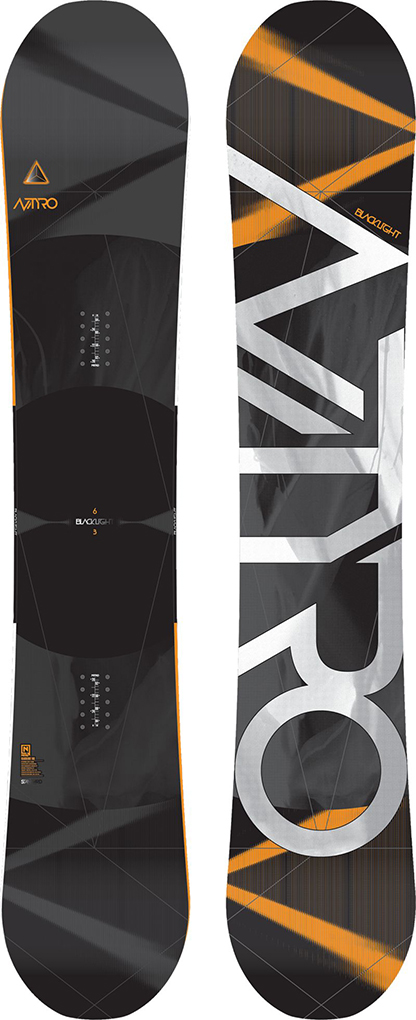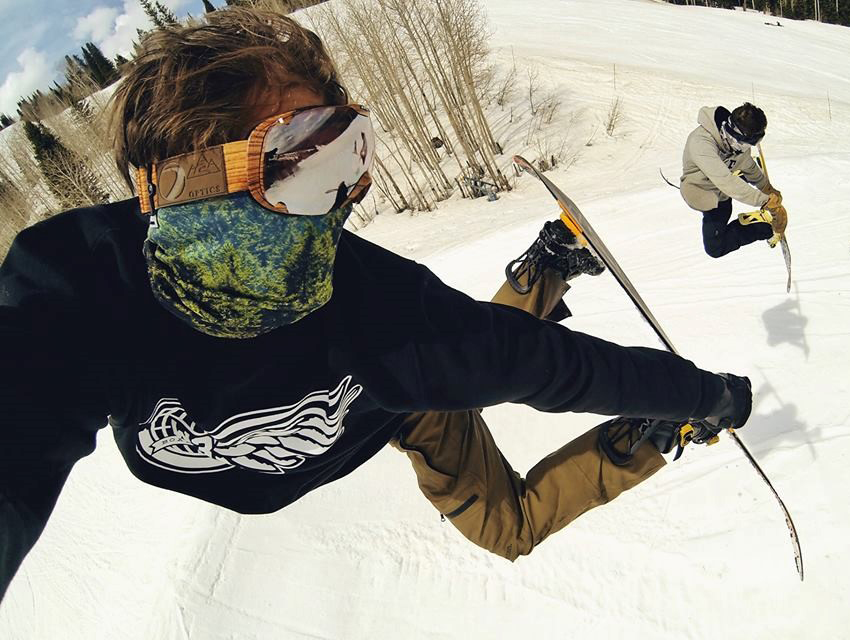
Nitro Blacklight, 162cm
Dimensions:
Waist Width: 258mm
Nose Width: 304mm
Tail Width: 304 mm
Setback: 15mm
Sidecut Radius: 8.8/7.8mm
Effective Edge: 1230mm
Bindings: Union Contact Pro
Boots: Nike Vapen
Stance: 23.5in
Angles: 17° front, -12° rear
MSRP: $649.95
Reviewer Info: 6’2″, 170 lbs.
Days Ridden: 15
Locations Tested: Guardsmans Pass, Little Cottonwood Canyon, Park City Mountain Resort, Snowbasin Resort, Brighton Resort, The Canyons Resort, Uintas National Forest, Utah.
When I snapped my Travis Rice Pro in the heavy northwest pow at Mt. Baker, I found myself looking for a hard charging, all-mountain, freestyle-oriented board to replace it while it was being warrantied. Nitro’s own Knut Eliassen suggested I check out the Blacklight, citing its cambered profile and all-mountain versatility.
Flex
In terms of flex, Nitro rates the Blacklight as a an 8 out of 10, 10 being the stiffest, and that seems pretty accurate. It is similar in stiffness to the Burton Easy Livin’ and slightly softer than the Lib Tech T Rice Pro.
Camber
When talking with Knut about what I was looking for in a board, it became clear that I was most interested in a traditionally cambered board.
Every company on the market has their own version of a reverse camber board, and I’ve ridden a number of them over the last couple years: Lib Tech’s BTX and C2 BTX; Never Summer’s RC camber; and Burton’s Flying V. I’ve never totally disliked boards with reverse camber. I’ve regularly ridden ones that combined regular camber between the feet and reverse camber tip and tail, or vice versa, and it has worked well enough for me.
But I hadn’t actually ridden a board with traditional camber in over five years, and was eager to try it again. I wanted to get back on something that made no sacrifices when it came to edge hold and responsiveness, and the Blacklight certainty doesn’t.
Carving / Groomers
Testing the Blacklight, I found myself getting on the mountain earlier than I would have riding other boards. In part this was because Park City has been over 60° F lately and the entire mountain turns to slush by 10:15, but also because the Blacklight’s camber and edge design makes railing some early morning corduroy very fun.
The board’s edges protrude out slightly under the toes and heels, similar to a Magne-Traction design, though at fewer points along the sidecut. This effectively increases the number of contact points along the Blacklight’s edges from 2 per edge (as on a traditionally cambered board with a normal edge design), to 4.
Edge to edge, the Blacklight is quick, and I found myself carving turns more than sliding through them, thanks to its camber, edge design, and the grip they collectively provide.
Through light pockets of pow and spring slush on groomers, the Blacklight was as stable as any other board I’ve ridden. Pinning it from the park to the lift at The Canyons was sketchy as temps rose, but the Blacklight powered through the slush and chunder with ease, aided by its length, rigidity, set-back stance, and wide nose. For similar reasons, I didn’t notice any decreased float in powder or loss of playfulness on the Blacklight, despite having traditional camber.
Backcountry and Park Jumps
Normally I would prefer that my first time riding a new board be inbounds in order to get a feel for how it handles. I didn’t have that opportunity with the Blacklight, though, as we had a step-down set up and were ready to film the first morning I had it mounted up.
Zeppelin’s latest edit, including shots on the Nitro Blacklight.
I spent nearly everyday hitting backcountry jumps on the Blacklight, with a few days of park riding sprinkled in between. In short, the Blacklight shines in the air.
The Blacklight is billed as a “Directional Twin,” because although the dimensions are perfectly symmetrical (both the tip and tail are 304mm wide), the stance is set back 15mm. This rearward stance helps the board stomp pow landings and stay afloat when hauling down lines in fresh snow.
Having never ridden a directional board, I was worried it would inhibit my ability to ride switch, but the Blacklight can hold its own riding switch on groomers, despite having a slightly shorter tail than nose. I sent one switch back 540 on the Blacklight on the second hit of my first day riding it, and its setback stance did make this landing a little awkward. For that reason, I don’t ride the Blacklight switch that often in powder.
Even with a weakness when it comes to switch landings and riding switch in powder, the Blacklight was my go-to board for park jumps as well as hitting backcountry kickers. Riding through King’s Crown at Park City, the Blacklight gave me absolute confidence when rolling through the largest jump line. The board is stiff enough for stable landings, yet lightweight and snappy enough to be fun in the air and on groomers. The Blacklight seemed at home wherever I took it.

All Mountain: Off-Piste
I generally like a board that is more lively than damp, since to me, boards that get described as “damp” often feel pretty “dead.”
The Blacklight is snappy, extremely lightweight, and packed with pop. It goes exactly where you want and reacts to minute movements. So for general, jib-oriented, all-mountain riding in softer conditions, I think the Blacklight is great. It probably won’t suit those looking for a decidedly damp board, however, as its poplar wood core gives it a lot of pop, but isn’t the most stable construction out there.
